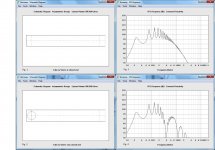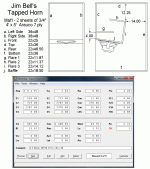Let's build a Tapped Horn, element by element. Figure 1 is a tube with a speaker capping the left
end and the right end open. Driving the air in the tube with a one watt signal, beginning at 10Hz
and sweeping up to 3000, and results in the response shown in figure 2.
It's easier to make a Tapped Horn if the speaker is near, but not at, the left end. Moving the
speaker to the side (fig.3) results in changing the response (fig.4), but only the response above
150 Hz.
Next, let's keep the volume the same (500 Liters) while we taper the tube (see fig.5). This
changes everything. While the curve (fig.5) is shifted slightly to the right, the response on average
is smoother and louder between 30 and 150 Hz.
Last, we add in the Tapped Horn effect! We add the input from the back of the driver near the right
side in figure 7. This raises the response (see fig.8) in the 40-70 Hz area while it lowers the peak
at 85Hz. The peaks at 135 and 200 Hz are much weaker than shown.
Questions?
Don
end and the right end open. Driving the air in the tube with a one watt signal, beginning at 10Hz
and sweeping up to 3000, and results in the response shown in figure 2.
It's easier to make a Tapped Horn if the speaker is near, but not at, the left end. Moving the
speaker to the side (fig.3) results in changing the response (fig.4), but only the response above
150 Hz.
Next, let's keep the volume the same (500 Liters) while we taper the tube (see fig.5). This
changes everything. While the curve (fig.5) is shifted slightly to the right, the response on average
is smoother and louder between 30 and 150 Hz.
Last, we add in the Tapped Horn effect! We add the input from the back of the driver near the right
side in figure 7. This raises the response (see fig.8) in the 40-70 Hz area while it lowers the peak
at 85Hz. The peaks at 135 and 200 Hz are much weaker than shown.
Questions?
Don
Attachments
Hi there Don: Can the four steps you showed be turned into a general method for starting a TH design for a specific driver? IE the tube must have an area slightly larger than the OD of the driver and the length should be related to the quater wave of the the chosen low corner hz, as a starting point. ...regards, Michael Droke
No ... the process shown helps understand the effects of the various elements, but is little help in creating a new design.
While some general rules can be used for a starting point, HornResp does the heavy lifting for us.
While some general rules can be used for a starting point, HornResp does the heavy lifting for us.
Last edited:
Hi littlemike – Working thru this example helped me. Should I put this in a “sticky”?
Hi Michael – In a tapped horn, everything is so interdependent, that tweaking one
Parameter (ie length between front & back of horn) seems to change many things.
Hi Michael – In a tapped horn, everything is so interdependent, that tweaking one
Parameter (ie length between front & back of horn) seems to change many things.
To Whom It May Concern (from the forthcoming 145th AES Convention, New York 2018):
P04-2 An Acoustic Model of the Tapped Horn Loudspeaker—Marco Berzborn, RWTH Aachen University - Aachen, Germany; Michael Smithers, Dolby Laboratories - McMahons Point, NSW, Australia
A lumped-parameter model of the Tapped Horn loudspeaker–a design where the loudspeaker driver radiates into the throat as well as the mouth of the horn simultaneously–is presented. The model enables the estimation of the far-field sound pressure response from the Thiele/Small parameters of the loudspeaker driver and an additional analytic two-port matrix representation of the Tapped Horn. Simulations, performed using the model for subwoofers, are compared to measurements from an actual loudspeaker.
Convention Paper 10047
P04-2 An Acoustic Model of the Tapped Horn Loudspeaker—Marco Berzborn, RWTH Aachen University - Aachen, Germany; Michael Smithers, Dolby Laboratories - McMahons Point, NSW, Australia
A lumped-parameter model of the Tapped Horn loudspeaker–a design where the loudspeaker driver radiates into the throat as well as the mouth of the horn simultaneously–is presented. The model enables the estimation of the far-field sound pressure response from the Thiele/Small parameters of the loudspeaker driver and an additional analytic two-port matrix representation of the Tapped Horn. Simulations, performed using the model for subwoofers, are compared to measurements from an actual loudspeaker.
Convention Paper 10047
To Whom It May Concern (from the forthcoming 145th AES Convention, New York 2018):
P04-2 An Acoustic Model of the Tapped Horn Loudspeaker—Marco Berzborn, RWTH Aachen University - Aachen, Germany; Michael Smithers, Dolby Laboratories - McMahons Point, NSW, Australia
This is very interesting indeed - thanks for posting.
By way of background:
I was contacted by Michael Smithers in April 2016. He was interested in obtaining a copy of the Hornresp source code for the TH1 tapped horn loudspeaker model. I was not prepared to release the code to Dolby Laboratories, but pointed him towards reference material that contained all the information required to develop a tapped horn model. In July 2016 he advised me that Marco Berzborn "has succeeded in making a tapped horn Matlab model and we are getting good results that compare well with HornResp".
It seems that the model now being documented is in effect the same as the one used in Hornresp - it will be interesting to see if the paper makes any mention of Hornresp 🙂.
I can't believe you have to purchase the paper!
AES New York 2018 >> Paper Session P04: Transducers—Part 1
AES New York 2018 >> Paper Session P04: Transducers—Part 1
I can share it with you but I'm not sure if it's in accordance with the forum policy? ^^
Yes David, Hornresp is the first in References 😉it will be interesting to see if the paper makes any mention of Hornresp 🙂.
It's just that I'm not sure if it's legal or not to share AES articles but I don't mind doing it 🙂
Yes David, Hornresp is the first in References 😉
Hi the lorn teat flag,
That is very nice to know 🙂.
Many thanks!
Kind regards,
David
For those who are interested in tapped horns 😀
Why did they use meters instead of centimeters when modeling the enclosure?
I see they use the Tom Danley style of measuring at 10 meters instead of 1 meter.
They should have read jbell's posts in his SS15 thread about corner reflectors.
For those who like tapped horns 😀
I LOVE tapped horns! The same number of boards (7) it takes to make a BR enclosure, you can make a tapped horn in its simplest form.
- Status
- Not open for further replies.
- Home
- Loudspeakers
- Subwoofers
- Elements of a Tapped Horn


